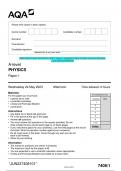Samenvatting
Summary Everything (lectures + chapters together) for the MIDTERM of medical neuroscience and neuroanatomy
- Instelling
- Vrije Universiteit Amsterdam (VU)
The lectures and chapters from the book have been combined in a clear summary. Here and there some Dutch bits have been added (green and italicized) so that it is also clear for Dutch students. Furthermore, many pictures have been used to illustrate and you will find more clear pictures at the end ...
[Meer zien]














